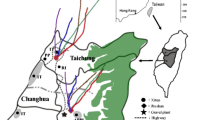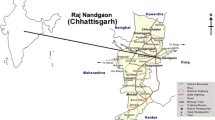Abstract
This study concerns insoluble chemical pollution in fog at the Milešovka Observatory in the Czech Republic. From August 2006 to July 2007, 25 fog samples at the top of Milešovka Mountain in the České Středohoří Mountain Range were collected with an active fog water collector. Water samples were filtered to obtain the insoluble particles. A range of 53–116 particles from every sample was chosen according to the quantity of the particles found in the dried filters. Altogether more than 2,000 particles were analyzed. The particles were examined with the help of a scanning electron microscope and energy dispersive X-ray spectrometer to distinguish sizes, shapes and composition. After analyzing the data, a statistical evaluation was made. The particles were categorized according to their shapes (spherical × non-spherical), sizes (coarse particles, PM2.5–10, PM1–2.5 and PM1) and composition. Typical (frequently represented) particles with a content of a given element greater than 5% (element-rich particles), such as Al-, Si-, K-, Fe- or Ca-rich particles were determined. The focus was also on particles with elements rarely represented in the atmosphere, like Ni, Au, Pb, Cu, Zr and Ba. Groups of typical insoluble particles were classified according to the meteorological conditions, synoptic situations and wind directions that prevailed in the days of the fog events to find out the possible sources of this fog pollution.




Similar content being viewed by others
References
Brádka, J., Dřevikovský, A., Gregor, Z. and Kolesár, J. (1961). Weather on Czech and Morivia Area in typical weather situations. Hydrometeorological Institute, Prague (in Czech).
Brook Robert, D. et al. (2004). Air pollution and cardiovascular disease: a statement for healthcare professional: from the American heart association, Circulation 109, 2655–2671.
Daube B., Kimball K.D., Lamar P.A., Weathers K.C. (1987). Two new ground-level cloud water sampler design which reduce rain contamination. Atmospheric Environment 21, 893–900, doi:10.1016/0004-6981(87)90085-0.
Fisak J., Rezacova D., Elias V., Tesar M. (2001), Comparison of pollutant concentrations in fog (low cloud) water in Northern and Southern Bohemia, Journal of Hydrology and Hydromechanics 49(5), 275–290.
Fisak J., Tesar M., Rezacova D, Elias V., Weignerova V., Fottova D. (2002a), Pollutant concentrations in fog and low cloud water at selected sites of the Czech Republic, Atmospheric Research 64(1–4), 75–87.
Fisak J., Rezacova D., Weignerova V., Tesar M. (2002b), Pollutant concentration in fog water samples from Milesovka, Report Series in Aerosol Science 56, 29–34.
Fisak J., Tesar M, Fottova D. (2009), Pollutant concentrations in the rime and fog water at Milesovka Mountain, Water, Air & Soil Pollution 194 (1–4), 273–285.
Hovorka J., Atmospheric aerosol, In atmosphere and climate: actual issues in meteorology, climatology and air protection (In Czech) (Ed. Braniš, M. and Hůnová, I.) (Karolinum, Prague, 2010), pp 121–139.
Li Weijun and Shao Longyi (2009), Characterization of mineral particles in winter fog of Beijing analyzed by TEM and SEM, Environmental Monitoring and Assessment 161, 565–573.
Lin Z.Q., Schemenauer R.S., Schuepp P.H., Barthakur N.N., Kennedy G.G. (1997), Airborne metal pollutants in high elevation forests of southern Quebec, Canada, and their likely source regions. Agriculture and Forest Meteorology 87(1), 41–54.
Monte Marco del and Rossi Paola (1997), Fog and gypsum crystals on building materials, Atmospheric Environment 31(11), 1637–1646.
Poppe III Arden C. and Dockery Douglas W. (2006), Health effects of fine particulate air pollution: lines that connect, Air & Waste Manage Assoc. 56, 709–742.
Schemenauer Robert S. (1986), Acid deposition to forests: the 1985 chemistry of high elevation fog (CHEF) project, Atmosphere-ocean 24(4), 303–328.
Stoyanova V., et al. (2010), SEM-EDX identification of particles from fog in an industrially polluted region of Czech Republic, Proceedings of 10th International Multidisciplinary Scientific Geoconference “Modern Management of Mine Producing, Geology and Environmental Protection” SGEM 2010 2, 269–276.
Štekl J. et al., Milešovka and the region of Milešovka (In Czech) (Academia, Praha, 2005).
Tesar M., Elias V., Sir M. (1995). Preliminary results of characterization of cloud and fog water in the mountains of Southern and Northern Bohemia, Journal of Hydrology and Hydrodynamics 43, 412–426.
Irz—Integrated Register of Pollution (In Czech) (2010), cit. 2010-06-22, Available on:http://www.irz.cz/latky/poletavy_prach.
Chmi—Czech hydrometeorological institute (In Czech) (2010), Typology of synoptic situation for the area of Czech Republic, cit. 2010-06-22, Available on:http://www.chmi.cz/portal/dt?menu=JSPTabContainer/P3_0_Informace_pro_Vas/P3_3_Historicka_data/P3_3_1_Pocasi/P3_3_1_11_Typizace_situaci&last=false.
Acknowledgments
The results described in this paper were obtained in the frame for AS CR and BAS collaboration with support of the GACR Project No. 205/09/1918, and the IRP No. AV0Z30420517.
Author information
Authors and Affiliations
Corresponding author
Rights and permissions
About this article
Cite this article
Fišák, J., Stoyanova, V., Bartůňková, K. et al. Typical Insoluble Particles in Fog Water at Milešovka Observatory (Czech Republic). Pure Appl. Geophys. 169, 1083–1091 (2012). https://doi.org/10.1007/s00024-011-0345-8
Received:
Revised:
Accepted:
Published:
Issue Date:
DOI: https://doi.org/10.1007/s00024-011-0345-8




